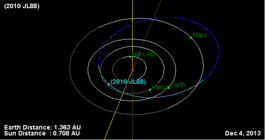2010 JL88
 Orbit of 2010 JL88 | |
| Discovery [1][2][3] | |
|---|---|
| Discovery site |
Siding Spring Survey (unaccredited) |
| Discovery date | 15 May 2010 |
| Designations | |
| MPC designation | 2010 JL88 |
| Apollo · NEO [4] | |
| Orbital characteristics [4] | |
| Epoch 13 January 2016 (JD 2457400.5) | |
| Uncertainty parameter 7 | |
| Aphelion | 2.1391 AU |
| Perihelion | 0.70654 AU |
| 1.4228 AU | |
| Eccentricity | 0.50343 |
| 1.70 yr (619.91 d) | |
| 89.113° | |
| 0° 34m 50.628s /day | |
| Inclination | 0.092387° |
| 269.02° | |
| 51.167° | |
| Earth MOID | 0.000956 AU |
| Physical characteristics | |
| Dimensions | 18.5±7.5 m[5] |
| 24.5 s (0.0068295 h)[4] | |
| 0.1[6] | |
| Temperature | 186–323 K[7] |
| 26.8[4] | |
|
| |
2010 JL88 is an unnumbered asteroid, classified as a near-Earth object of the Apollo group, approximately 19 meters in diameter.[2] It was first observed by the Siding Spring Survey, Australia, on 15 May 2010. It is known to be the fastest rotator with an unambiguous period solution, having an exceptionally rapid rotation period of less than 25 seconds.[4][8]
On May 17, 2010, it passed 0.00257 AU (384,000 km) from Earth.[4] It is on the lower of the Sentry Risk Table.[1]
Earth impact possibility
2010 JL88 has an Earth minimum orbit intersection distance of 0.45 Lunar Distances[9] However, it only has a 1 in 1,449,000 (0.000069%) chance of impacting into Earth sometime after 2049.[1] Even if it did impact, 2010 JL88 is so small that it would simply disintegrate in a manner similar to the Chelyabinsk meteor.[10]
Rotation
The asteroid was found to have a rapid rotation by the Magdalena Ridge Observatory's 2.4-meter telescope. It rotates at an extremely rapid rate of 24.5 seconds. 2010 JL88 is the second fastest natural rotating object discovered in the Solar System,[8] after 2014 RC, which has a period of 16 seconds but still an uncertain period solution.
See also
References
- 1 2 3 "2010 JL88 Impact Risk". Jet Propulsion Laboratory. National Aeronautics and Space Administration. August 8, 2013. Retrieved 31 March 2016.
- 1 2 "2010 JL88". Minor Planet Center. Retrieved 20 September 2016.
- ↑ "The Tracking News". hohmanntransfer.com. May 18, 2010. Retrieved 3 December 2013.
- 1 2 3 4 5 6 "JPL Small-Body Database Browser: 2010 JL88" (2010-05-17 last obs.). Jet Propulsion Laboratory. Retrieved 20 September 2016.
- ↑ Blobrana (May 17, 2010). "Asteroid 2010 JL88". Retrieved 3 December 2013.
- ↑ "Conversion of Absolute Magnitude to Diameter for Minor Planets". Sephen F. Austin State University. Dan Burton. Archived from the original on 10 December 2008. Retrieved 26 November 2013.
- ↑ "HEC: Exoplanets Calculator". Planetary Habitability Laboratory. University of Puerto Rico at Arecibo. Retrieved 10 December 2014.
- 1 2 Ryan, Eileen V.; Ryan, W. H. (October 2010). "Rotation Rates of Very Small Near-Earth Asteroids". American Astronomical Society. 42: 1086. Bibcode:2010DPS....42.6003R. Retrieved 20 September 2016.
- ↑ "Comets and Asteroids: (2010 JL88)". Find the Data. November 11, 2013. Retrieved 8 December 2013.
- ↑ Hamilton, Douglas. "Solar System Collisions". Astronomy Workshop. Retrieved 8 December 2013.
External links
- Asteroid Lightcurve Database (LCDB), query form (info)
- 2010 JL88 at NeoDyS-2, Near Earth Objects—Dynamic Site
- Ephemeris · Obs prediction · Orbital info · MOID · Proper elements · Obs info · Physical info · NEOCC
- 2010 JL88 at the JPL Small-Body Database
